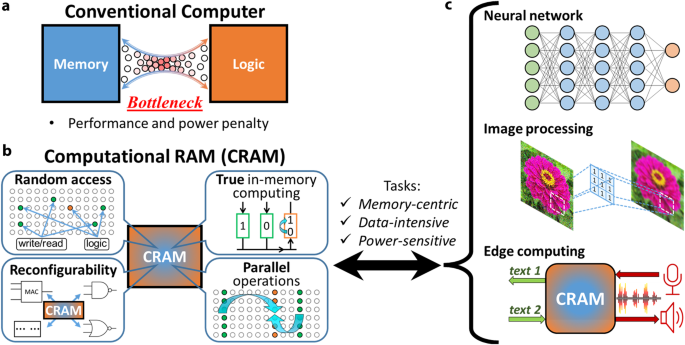2024-07-25 ミネソタ大学
<関連情報>
- https://cse.umn.edu/college/news/researchers-develop-state-art-device-make-artificial-intelligence-more-energy
- https://www.nature.com/articles/s44335-024-00003-3
磁気トンネル接合ベースの計算ランダムアクセスメモリを実験的に実証 Experimental demonstration of magnetic tunnel junction-based computational random-access memory
Yang Lv,Brandon R. Zink,Robert P. Bloom,Hüsrev Cılasun,Pravin Khanal,Salonik Resch,Zamshed Chowdhury,Ali Habiboglu,Weigang Wang,Sachin S. Sapatnekar,Ulya Karpuzcu & Jian-Ping Wang
npj Unconventional Computing Published:25 July 2024
DOI:https://doi.org/10.1038/s44335-024-00003-3

Abstract
The conventional computing paradigm struggles to fulfill the rapidly growing demands from emerging applications, especially those for machine intelligence because much of the power and energy is consumed by constant data transfers between logic and memory modules. A new paradigm, called “computational random-access memory (CRAM),” has emerged to address this fundamental limitation. CRAM performs logic operations directly using the memory cells themselves, without having the data ever leave the memory. The energy and performance benefits of CRAM for both conventional and emerging applications have been well established by prior numerical studies. However, there is a lack of experimental demonstration and study of CRAM to evaluate its computational accuracy, which is a realistic and application-critical metric for its technological feasibility and competitiveness. In this work, a CRAM array based on magnetic tunnel junctions (MTJs) is experimentally demonstrated. First, basic memory operations, as well as 2-, 3-, and 5-input logic operations, are studied. Then, a 1-bit full adder with two different designs is demonstrated. Based on the experimental results, a suite of models has been developed to characterize the accuracy of CRAM computation. Scalar addition, multiplication, and matrix multiplication, which are essential building blocks for many conventional and machine intelligence applications, are evaluated and show promising accuracy performance. With the confirmation of MTJ-based CRAM’s accuracy, there is a strong case that this technology will have a significant impact on power- and energy-demanding applications of machine intelligence.



